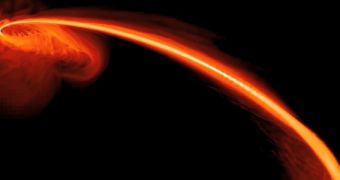Astronomers at the Georgia Institute of Technology (Georgia Tech) are currently working on a new approach to detect instances at the cores of galaxies where black holes eat up unfortunate stars that stray too close to their event horizons. Such events are believed to produce enormous bangs, huge amounts of radiations, and a beacon visible even from Earth, but studying them has proven difficult.
Observing these phenomena is complicated because black holes, by their very nature, do not produce any type of light. In fact, they gobble up whatever light is around them, hence their name. Some time ago, astronomers noticed that the cores of certain distant galaxies that appeared to be inactive flared up at one point or another.
One way to interpret these readings is that a star in the central sector of those galaxies strayed too close to the supermassive black hole occupying that region. The unfortunate celestial body may have then been entirely destroyed by the encounter, as simulated in the image above. The process is believed to be capable of generating huge amounts of radiations, experts say.
The thing experts are most interested in at this point is creating the theoretical framework for detecting such events. New models are constantly being developed to predict how these stellar catastrophes would appear on our detectors, as well as the factors that would separate such phenomena from the more common supernova explosions that rock galaxies from time to time.
“Black holes by themselves do not emit light. Our best chance to discover them in distant galaxies is if they interact with the stars and gas that are around them,” explains Georgia Tech assistant professor of physics Tamara Bogdanovic. She says that investigations carried out over the past few years have revealed instances where previously inactive galactic cores lit up again.
“This flare of light was found to have a characteristic behavior as a function of time. It starts very bright and its luminosity then decreases in time in a particular way. Astronomers have identified those as galaxies where a central black hole just disrupted and 'ate' a star. It's like a black hole putting up a sign that says ‘Here I am’,” the expert adds.
She and her team are currently developing a comprehensive technique for predicting the dynamics of star-black hole interactions, which relies on the use of both theoretical and computer-based approaches. The process wherein a black hole consumes a nearby star is known as tidal disruption.
For their study, experts are using the Texas Advanced Computing Center (Stampede) and the National Institute for Computational Sciences (Kraken). Both of these facilities are sponsored by the US National Science Foundation (NSF).
“There are many situations in astrophysics where we cannot get insight into a sequence of events that played out without simulations. We cannot stand next to the black hole and look at how it accretes gas. So we use simulations to learn about these distant and extreme environments,” Bogdanovic concludes.

 14 DAY TRIAL //
14 DAY TRIAL //